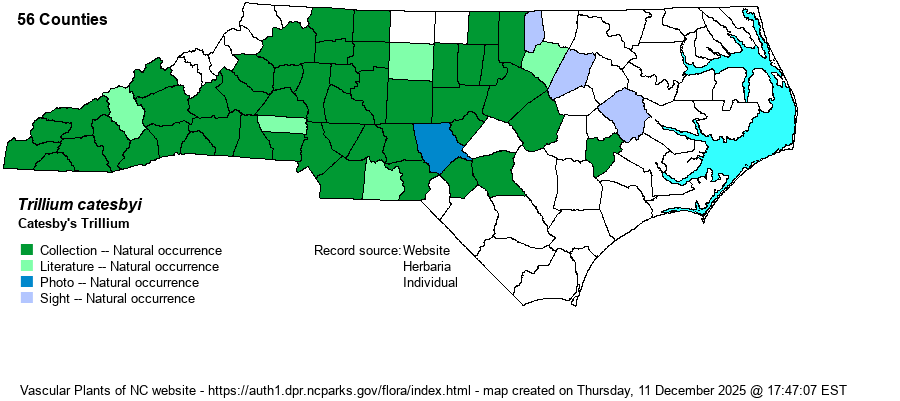| Author | Elliott | |
| Distribution | Occurs over nearly all of the Piedmont, the southern half of the Mountains, and into the western part of the Coastal Plain. Absent from the extreme northeastern corner of the Piedmont (Warren, Halifax, and Northampton counties), and seemingly absent from all Mountain counties north of Madison and Buncombe. Very rare the Sandhills proper, ranges farther east in the Coastal Plain to Pitt and Lenoir counties.
This is a Southeastern species ranging north only to northern NC (not yet found in VA) and eastern TN, and south to southern GA and southern AL (and also lacking from FL). Thus, it is known from just five states, though there are records for most counties within this fairly tight range. | |
| Abundance | Fairly common to reasonably common and widespread across most of the Piedmont, not as restricted in habitats as are most Piedmont trilliums. Infrequent to fairly common in the southern Mountains, and rare in the Coastal Plain portion of the range. | |
| Habitat | This species is one of the few trilliums that occurs in somewhat acidic soils, particularly in the Piedmont. It favors Mesic Mixed Hardwood Forests, bottomland hardwood forests, and cove forests in the foothills and mountains. It usually is not found in Basic Mesic Forests in the Piedmont. |
| Phenology | Blooms from late March into early June. In the Piedmont it is most often found blooming in the latter 20 days of April into early May. It fruits in July and August. | |
| Identification | This is one of the trillium species with solidly green leaves; many members of the genus in NC have strongly mottled leaves. Of the green-leaved group, it is the only one having pink flowers with the flowering stalk (pedicel) bent downward, such that the flower blooms below the level of the leaves. Each plant grows to about 9-10 inches tall, with each of the three leaves being widely ovate to elliptical, about 4 inches long and about 3 inches wide. The three petals are generally pink to rarely white, about 1.5-2 inches long, about 2/3-inch wide, and strongly recurved; the flower generally faces/hangs downward, such that obtaining a good photo of the "front" of the flower requires getting very close to the ground. When not in bloom, it could be confused with a few other species, though mainly with T. rugelii in the Piedmont but with others like T. grandiflorum in the mountains. These usually have larger leaves, but it is better not to try to attempt trillium identification without flowers. In fact, nearly all keys in references use flowers and flowering stalks as the major characters in identification; mottled versus un-mottled leaves are useful to "split" the state's trillium species into two groups, but beyond that, it is floral characters that are essential for positive identification. For most people in the state, especially in the eastern half of the state, this is the most often seen trillium, found on many spring walks in rich slopes and bottomlands. In fact, in most of the eastern half of the state, this is the only trillium species to be seen. | |
| Taxonomic Comments | Note: the spelling of the species name has been changed to catesbyi, following a paper by Weakley and Poindexter (2020 in press).
| |
| Other Common Name(s) | Bashful Trillium, Rosy Wake-robin | |
| State Rank | S4 [S5] | |
| Global Rank | G4 [G5] | |
| State Status | | |
| US Status | | |
| USACE-agcp | | |
| USACE-emp | | |

